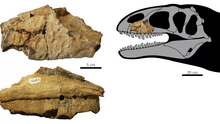|
Ulughbegsaurus
Ulughbegsaurus (meaning "Ulugh Beg's lizard") is an extinct genus of carcharodontosaurian theropod dinosaurs from the Late Cretaceous Bissekty Formation, Uzbekistan. The type species is Ulughbegsaurus uzbekistanensis. Discovery and namingThe Ulughbegsaurus fossil material was discovered in the Bissekty Formation, Uzbekistan in the 1980s. The holotype specimen, UzSGM 11-01-02, consists of a partial left maxilla. This specimen remained in the collection of the State Geological Museum of the State Committee of the Republic of Uzbekistan on Geology and Mineral Resources, Tashkent, Uzbekistan, until 2019, when it was rediscovered. Two additional specimens have been referred to the genus, including CCMGE 600/12457, the jugal ramus of a left maxilla that was previously referred to the dromaeosaurid Itemirus, and ZIN PH 357/16, the posterior end of a right maxilla.[1] Isolated teeth from the Bissekty Formation show similarities to carcharodontosaurians, suggesting they may belong to Ulughbegsaurus or possibly another genus of carcharodontosaurian.[1] In 2021, Tanaka and colleagues described Ulughbegsaurus uzbekistanensis as a new genus and species of theropod dinosaur, honouring the 15th century Timurid sultan and scientist Ulugh Beg and the country of its discovery.[1] A partial Acrocanthosaurus-like posterior dorsal vertebra described in 2024 has also been found in the Bissekty Formation, which could belong to Ulughbegsaurus.[2] DescriptionThe body length of Ulughbegsaurus is estimated at 7.5–8 metres (25–26 ft) and its body mass at over 1,000 kilograms (2,200 lb).[1] ClassificationTanaka et al. (2021) ran two phylogenetic analyses using two different datasets to determine the relationships of Ulughbegsaurus. The first placed it in a polytomy including Neovenator and other megaraptorans, while the second placed it in a polytomy including other basal carcharodontosaurians; megaraptorans were instead recovered as members of the Tyrannosauroidea. Both analyses are shown below:[1]
A 2022 study suggested that the taxon was a nomen dubium due to lacking diagnostic features, and that it was plausible that the maxilla fragment originated from a dromaeosaurid instead.[3] However, these authors later commented that the discovery of a more complete theropod maxilla fragment from older Uzbekistani rocks, comparable to the Ulughbegsaurus holotype, confirmed that the genus is a valid carcharodontosaurian taxon, possibly within the Carcharodontosauridae.[2] PaleoecologyUlughbegsaurus coexisted in the Bissekty Formation environment with other carnivorous theropods, including the tyrannosauroid Timurlengia and the dromaeosaurid Itemirus.[1][4] References
|
||||||||||||||||||||||||||||||||















